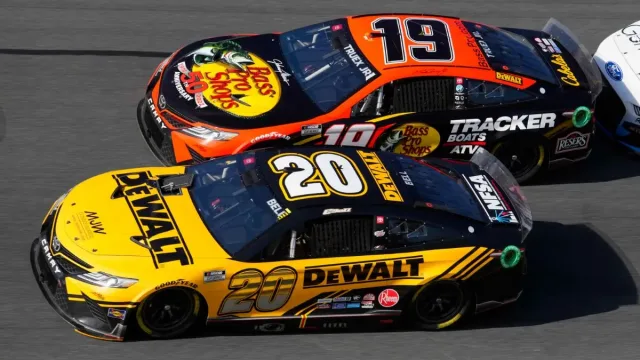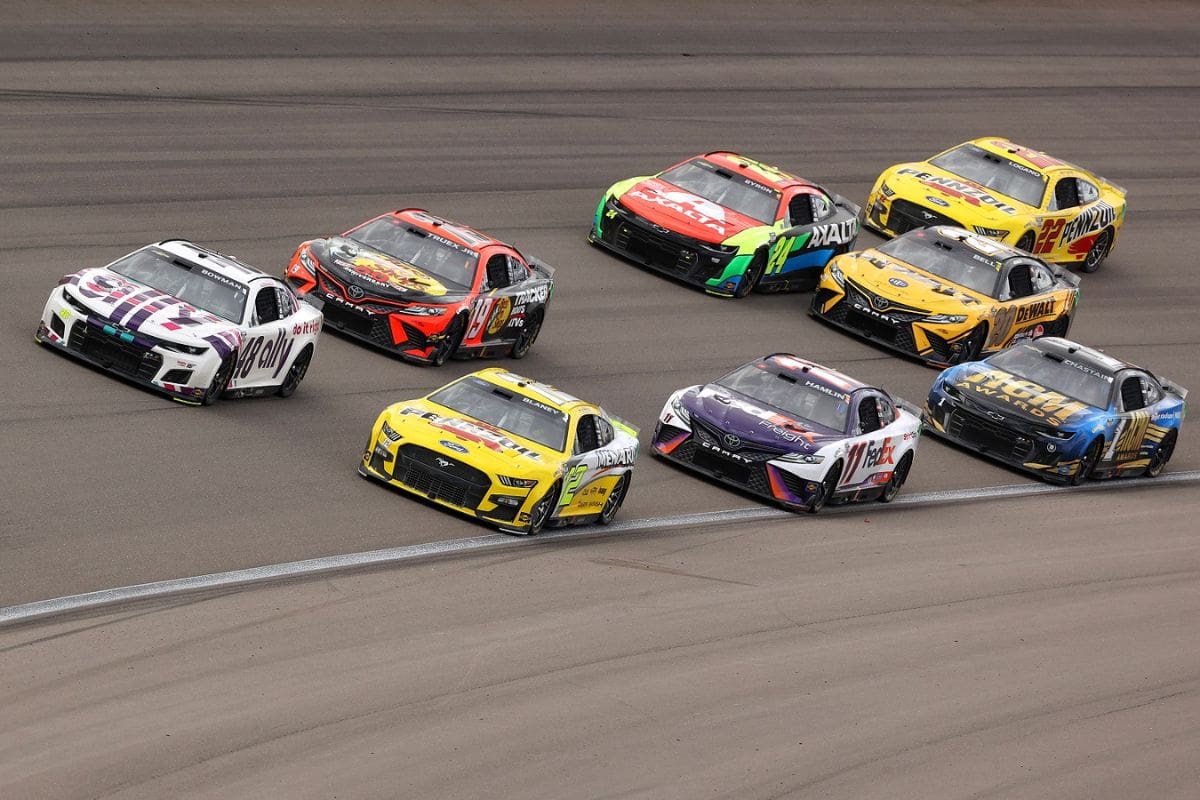Joe Gibbs Racing’s Confidential Pay System Disclosed: Joe Gibbs Racing employs a dual-layered pay system that intertwines base salaries with performance-based bonuses. This structure guarantees that driver compensation is directly tied to individual achievements, promoting a competitive atmosphere. While top earners, like Denny Hamlin, command notable salaries—reflecting their marketability—lower-tier drivers, such as Christopher Bell, experience considerable pay disparities based on performance metrics.
Key Highlights
- Joe Gibbs Racing employs a dual-layered pay system linking salaries to individual performance, promoting competition among drivers.
- The extensive bonus program incentivizes achievements like race wins and playoff qualifications, fostering a culture of accountability.
- Driver salaries vary significantly, with top earners commanding higher salaries based on marketability and performance metrics.
- The transparency of specific earnings figures raises questions about fairness and equity among drivers within the organization.
- High-stakes racing introduces risks that can impact drivers’ earnings, emphasizing the need for performance consistency to ensure financial stability.
Joe Gibbs Racing’s Estimated Value and Standing in NASCAR
In the competitive landscape of NASCAR, Joe Gibbs Racing (JGR) stands out with an estimated total asset value of $230 million, positioning it as the alternative most valuable team in the sport, just behind Hendrick Motorsports. This valuation highlights JGR’s prominence, reflecting not only financial robustness but also competitive performance on the track.
As of 2024, JGR is distinctly positioned as one of the two teams, alongside Hendrick, that fields four cars at the sport’s highest level, a strategy that amplifies both brand visibility and market share.
The financial strength of JGR is indicative of a well-structured organization capable of attracting top-tier talent and sponsorships. This valuation is further supported by the team’s historical success, evidenced by its five Cup Series championships, which contribute to sustained revenue streams through merchandise sales, broadcasting rights, and commercial partnerships.
However, the challenge remains in balancing driver salaries with operational costs. While JGR drivers rank among the highest-paid in stock car racing, the competitive nature of NASCAR demands that team owners, including the esteemed Joe Gibbs, navigate complex financial ecosystems.
This balancing act is critical, as it not only affects team morale but also impacts general performance. In this situation, JGR’s financial strategy serves as a case study in effectively managing resources while aiming for excellence on the racetrack.
JGR’s Bonus Program for Drivers and Crew Members
Joe Gibbs Racing (JGR) has implemented an extensive bonus program designed to incentivize both drivers and crew members, reflecting the team’s commitment to performance and excellence. This program is essential in fostering a culture of achievement and teamwork, vital in the competitive landscape of NASCAR. The bonus structure is carefully crafted to reward individual and collective success, thereby aligning the interests of both drivers and crew members with the overarching goals of the organization.
JGR’s tactical framework not only emphasizes financial rewards but also serves as a motivational tool, encouraging drivers and crew members to excel in their respective roles. The program’s design reflects a thorough understanding of the NASCAR ecosystem, reinforcing JGR’s status as a formidable competitor.
As the team continues to evolve, the bonus program will likely adapt to guarantee it remains relevant and effective in nurturing talent while driving performance. Ultimately, this approach solidifies JGR’s reputation as a leader in both racing achievement and organizational integrity, setting a benchmark in the industry.
Dave Alpern’s Insights on Driver Pay Structure at JGR
Dave Alpern’s recent disclosures about the driver pay structure at Joe Gibbs Racing (JGR) illuminate the intricacies of compensation within the organization. His insights reveal a dual-layered pay system designed to align driver incentives with team performance. Alpern clarified that JGR drivers receive both a base salary and a share of the purse, which is distributed based on individual performance metrics. This structure not only rewards drivers for their weekly race standings but also encourages a competitive spirit throughout the season.
The payout mechanism is thoughtfully structured to promote teamwork and individual excellence. Alpern articulated that the race purse is divided into portions for team employees, the team itself, and the drivers, with the latter’s compensation contingent upon their finishing position both weekly and annually. Such an arrangement highlights the importance of performance, ensuring that drivers are motivated to excel at every race.
“[JGR] drivers not only have a base salary, but yes, they get a portion of the purse just like the team does. So a driver has an incentive to win a race. So, every week, when we get the purse paid out, that purse gets divided. A portion goes to all the employees on an employee bonus. A portion goes to the team. And a portion goes to the driver based on their weekly finishing position and their year-end finishing position.” – Dave Alpern
View this post on Instagram
Moreover, this pay structure reflects an understanding of the high-stakes environment of NASCAR, where results directly impact financial outcomes. By integrating performance-based bonuses into the compensation framework, JGR not only fosters a culture of accountability but also aligns the interests of drivers with those of the organization.
Ultimately, Alpern’s insights provide a clearer picture of how JGR’s compensation strategy serves as a catalyst for success, balancing individual ambition with collective team goals in a highly competitive landscape.
Payout Variation Based on Performance for JGR Drivers
Frequently, the payout structure for JGR drivers demonstrates a direct correlation between performance and financial reward, emphasizing the competitive nature of NASCAR. This compensation model is designed to incentivize drivers, rewarding those who excel in races and ultimately progress through the playoff stages. For instance, drivers like Denny Hamlin and Christopher Bell, who advance further in the playoffs, can expect considerably higher earnings compared to their counterparts, such as Ty Gibbs or Martin Truex Jr., who may not achieve the same level of success.
Such a tiered payout system not only reflects the performance metrics of each driver but also aligns with the overarching goal of fostering competition within the team. The financial implications of a driver’s performance can be profound, leading to exponential variations in the total earnings accrued over a season. This dynamic is indicative of a meritocratic structure, where success on the track translates into tangible rewards.
However, the intricacies of this payout system raise questions regarding transparency. While the general framework is understood, the precise figures associated with each driver’s earnings remain elusive, shrouded in confidentiality.
This opacity can complicate discussions surrounding fairness and equity in compensation. As the NASCAR landscape continues to evolve, the effectiveness of this performance-based payout structure will be scrutinized, particularly in its ability to attract and retain top talent within JGR while maintaining a competitive edge in the sport.
The Pay Ladder of Coach Gibbs’ Top Drivers
Navigating the financial landscape of Joe Gibbs Racing (JGR) reveals a structured pay ladder that reflects both performance and market dynamics. The team’s impressive estimated sponsor revenue of $98.95 million in 2023, combined with supplementary earnings from race performance, positions JGR’s annual revenue at over $110 million. This financially strong framework allows for a relatively stable payroll structure among its drivers.
At the base of this pay ladder is Christopher Bell, earning approximately $850,000 annually. Despite being the lowest-paid driver, his recent performance path suggests potential salary increases in the future.
Next is Ty Gibbs, reportedly earning close to $1 million per year, a figure reflecting his status as the third-highest paid driver within JGR, enhanced by familial connections to Coach Gibbs.
The pay scale rises considerably with Martin Truex Jr., who, though departing after the 2024 season, commanded a salary nearing $10.3 million. The uncertainty surrounding his replacement, Chase Briscoe, indicates that JGR’s compensation strategy may adapt to market conditions and driver performance metrics.
Denny Hamlin stands at the apex, with a salary of $13.1 million, making him not only JGR’s highest earner but also one of NASCAR’s top-tier salarymen.
This structured pay system highlights the correlation between performance, marketability, and financial reward, validating the high-stakes nature of NASCAR and the inherent risks taken by its drivers. Consequently, the pay ladder at JGR serves as a reflection of both individual merit and the competitive landscape of motorsport.
News in Brief: Joe Gibbs Racing’s Confidential Pay System Disclosed
The analysis of Joe Gibbs Racing’s pay structure reveals a complex system influenced by performance metrics and individual contributions. Variations in compensation among drivers and crew members highlight the competitive nature of NASCAR, where monetary rewards reflect both achievement and potential.
Insights from Dave Alpern emphasize the tactical design of the bonus program, aiming to incentivize excellence. Ultimately, while the pay system aligns with industry standards, its fairness remains subject to interpretation, contingent on diverse stakeholder perspectives.
ALSO READ: Joe Gibbs Racing Chases Owner’s Championship as Aric Almirola Admits #20 Car Lacks Speed



